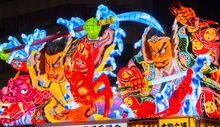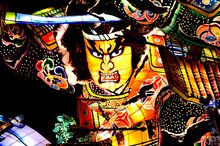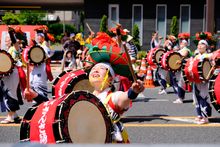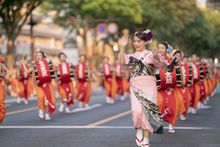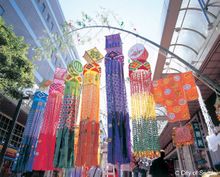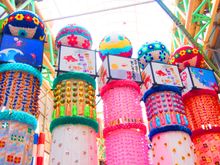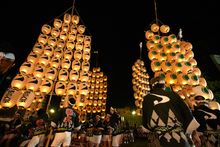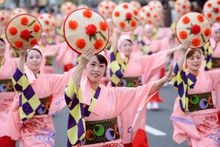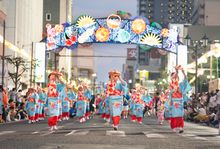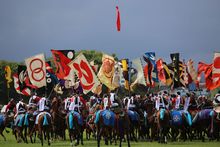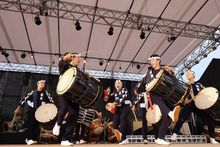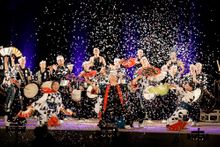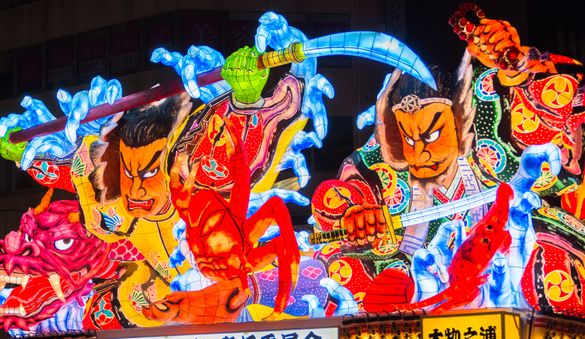 11 Aug 2022
11 Aug 2022
Tags: Tohoku, Festival, aomori, akita, Iwate, Yamagata, Miyagi, fukushima, Niigata, Japan, Summer, history & culture

There is no better way to celebrate Japan’s summer season than the hot excitement of authentic Japanese festivals! Piping-hot food, fiery dancing, soaring spirits - and Northern Japan’s Tohoku area boasts some of the best!
Submerse yourself in the bright colors, feel the rhythmic music wash over you, dive into the savory aromas and tastes of festival food! Your senses will be tantalized by the excitement of the Tohoku area’s jubilant celebrations!
Getting swept up in the excitement of a summer festival is a must for every visitor to Japan. And it’s no wonder! Japanese festivals, or matsuri, are famous for their vibrant dancing, costumes, and firework displays. Not to mention the street food! Each festival features its own captivating origin story and one-of-a-kind appeal.
Throughout the short summer of northern Japan, the people of the Tohoku area pour their passion and joy for life into their local festivals. Although its winters are typically cooler than its southern counterparts, summertime in the Tohoku area heats things up as the local populace puts their hearts and minds together as one to raise excitement and temperatures to a fever pitch!
Today we’ll take you on a virtual tour of seven of those summer festivals - the best in Tohoku and some of the most exciting in Japan. Grab your fan and *zouri to keep cool, and come join the fun!
*Thonged Japanese sandals made of rice straw, cloth, etc. Zouri are a slip-on descendant of the tied-on waraji (straw) sandal.
Aomori’s “Nebuta Matsuri” Festival: A festival like no other!
Awe-inspiring floats parading through the streets.
This sensational event is almost as if the Aomori residents had bottled up their energy over the long, harsh northern winter, and let it out like freshly uncorked champagne, sending up a shower of excitement during the short summer season.
The street becomes a river of luminously colored lantern-floats continually gliding along Their kabuki-like designs coming to life in a vivid, three-dimensional art style.
Although the origin of Nebuta is disputed, the impressive craftsmanship and sheer size of these parading works of art is indisputably breathtaking! This so-called “kabuki on wheels” amazes and entertains festival-goers of all ages. The street becomes like a river as the luminously colored Nebuta lanterns continually glide along, one after the other, with their kabuki-like designs nearly coming to life with their vivid, three-dimensional art style.
Highlighted by fireworks in the evening sky, musical performances provide the soundtrack to these moving theaters while spectators cheer their hearts out. As it’s being held for the first time in three years, it is truly a spectacle not to be missed!
World record holder for wadaiko drums!
Held annually at the beginning of August, the Morioka Sansa Dance holds the world record for most wadaiko (Japanese drums) played in unison in a performance. The current record of 3,437 drummers has stood since 2014.
The festival itself is a celebration of liberation from an oni (demon) that once terrorized Morioka. After hearing the pleas of the local people, the deity Mitsuishi-kami caught and forced the demon to swear to never again menace the people. To symbolize his promise, the demon left his handprint in a rock. This “oni no tegata” (demon’s stone handprint) is said to be the origin of Iwate Prefecture’s name. “Iwate” literally means “rock hand”.
And just as the festival originated from a legend, the festival itself continues to be legendary - with its record-setting drummers and bamboo flutes creating an exhilarating accompaniment to the parade of Sansa dancers. Dressed in colorful traditional costumes, the dancers are led by “Miss Sansa Odori” dancers, who have been chosen to lead the dance groups because of their beauty and lively personalities.
In addition to those performances, giant circle dances are also conducted, with the dance instructors encouraging all spectators to join in ! Visitors are sure to enjoy celebrating alongside the dancers, who perform with the unbridled joy of citizens released from demonic tyranny.
Colorful paper and elegant bamboo
Celebrated in Japan for over 1000 years, the Tanabata Festival is widely enjoyed all over Japan. What makes the Sendai Tanabata Festival special are its decorations. The countless lacy garlands fall in cascades several meters long. The giant, colorful streamers are hung under the roofs of the shopping arcades and elsewhere throughout the city, creating a magical, dream-like atmosphere.
Indeed, the Tanabata Festival is a story of magic and romance wherein two heavenly lovers are able to meet only upon the seventh night of the seventh month according to the lunar calendar. The fireworks of the festival are representative of the romantic sparks that fly between the pair as they reunite after being apart for so long.
Given that the Sendai Tanabata Festival is held August 6 to 8, astute readers will note that the dates do not match with the story. This is due to Sendai holding its festival based on a calendar that is one month ahead of the old Chinese calendar. For further reading on the history of the Sendai Tanabata Festival, check out the following URL:
https://www.sendaitanabata.com/english/pc/outline/history/
Come join the more than 2 million visitors to Sendai enjoying the bamboo decorations across the city!
A pole lantern festival of physical feats and enchanting towers of light.
One of the most enchanting and thrilling festivals in the Tohoku area, or throughout Japan for that matter, is Akita’s Kanto Festival. With a history of nearly 270 years, it’s recognized as a National Important Intangible Folk Cultural Property. Originally intended as a prayer for bountiful harvests, enormous pole lanterns are carried up and down the nearly one kilometer stretch of road.
Composed of paper lanterns set on long bamboo poles, the kanto reach up to 12 meters in height, carry up to 46 lanterns, and weigh up to 50 kilograms, making this parade not only visually stunning, but an impressive physical feat on the part of the lantern bearers. What’s more, the lanterns are lit with real candles - a rare remnant of days gone past - another testament to the authenticity of this unique festival. Seeing the soft, yellow glow, one can easily imagine how people nearly three centuries ago enjoyed the same sights.
Having inherited their skills from their fathers, and their fathers before them, the lantern bearers carry the tiered lanterns up and down the nearly one kilometer stretch of road, with lanterns bearing the name and crest of one’s community.
Performances continue throughout the day, with competitions among the lantern bearers. As well, there are opportunities for audience members to interact with them and to try their hand at balancing these towering, festive lights.
Finally, the highlight (pun intended) of the festival comes in the evening. All the performers raise their lanterns at the same time, creating what can appear as fields of golden rice ears swaying back and forth - symbolic of the prayer for bountiful harvests.
The Akita Kanto Festival is a visually stunning experience that will leave a long-lasting impression! Come witness the beauty first hand!
Performers and spectators alike feel the joy of this flowery festival.
It’s no surprise that the Yamagata Hanagasa Festival brings in around 1 million visitors annually. With more than 10,000 dancers parading down Yamagata City’s main street, visitors enjoy a variety of dynamic dances with beautifully choreographed moves. The dancers, wearing colorful traditional costumes, are accompanied by pounding hanagasa drums.
And though that may sound like any other dance festival in Japan, the Yamagata Hanagasa dance is unique in that during the 1970 Expo in Osaka, it was selected to be showcased to the world as a prime example of Japanese folk art. Naturally, it’s well-known throughout Japan, and is a representative dance of Yamagata Prefecture.
The conical hats decorated with safflowers, Yamagata’s flower, are a necessary part of the dancers’ costume and make these dances easily recognizable. Whether it’s the onna odori (female dance) or the otoko odori (male dance), visitors are sure to enjoy just watching or even joining in with some of the easier dances.
Japan’s Warring States Period appears before your eyes!
Originating a millennium ago in the Minamisoma area, the origin of the Soma Nomaoi Festival lies in the capture and training of horses for the military. And though the festival has since evolved, horses continue to be a central theme in the festivities. A unique horseback “capture-the-flag” event evokes images of a battle from the days of Japan’s Warring States Period. There’s also a thrilling horse race where bright banners pass by in a blur of color. The thundering of pounding hooves and the clamor of armor and weapons is sure to thrill festival-goers of all ages.
During the events, locals are decked out in traditional samurai armor passed down generation to generation. The somber street parade is a good opportunity for visitors to observe the details of the beautiful armor more closely.
The climax is the Nomakake event, which is a reenactment of a wild horse being captured by men chasing after it on foot, who then dedicate it to the shrine.
International Art Festival aims to connect the world
This year marks the 35th anniversary of the Sado Earth Celebration festival. This is a huge cultural event on the largest island of the Tohoku area in Northern Japan. Drummers from Kodo, the world’s top *taiko troupe, host the event and invite artists and entertainers from around the world to create a new global culture. This year’s theme is “tataku” (to strike, or beat a rhythm).
(*taiko = Japanese drum)
The highlight of the Sado Earth Celebration is the climactic taiko performance on the final day of the festival. Wearing traditional attire, performers pound on the giant drums, first on stage, and then among the audience. The thundering sounds overpower everything else. Festival-goers can’t help but to feel a connection with the performers through the energy of the drums.
Choosing the festival for you
With so many exciting festivals to choose from, it might be impossible to visit them all. But on the other hand, there is a broad range of themes among these seven festivals. Whichever you choose is sure to make your summer in Japan’s Tohoku area one of the hottest, most exciting, and most authentic experiences you’ve ever had!
***Please don't use images or contents for commercial purposes.***

